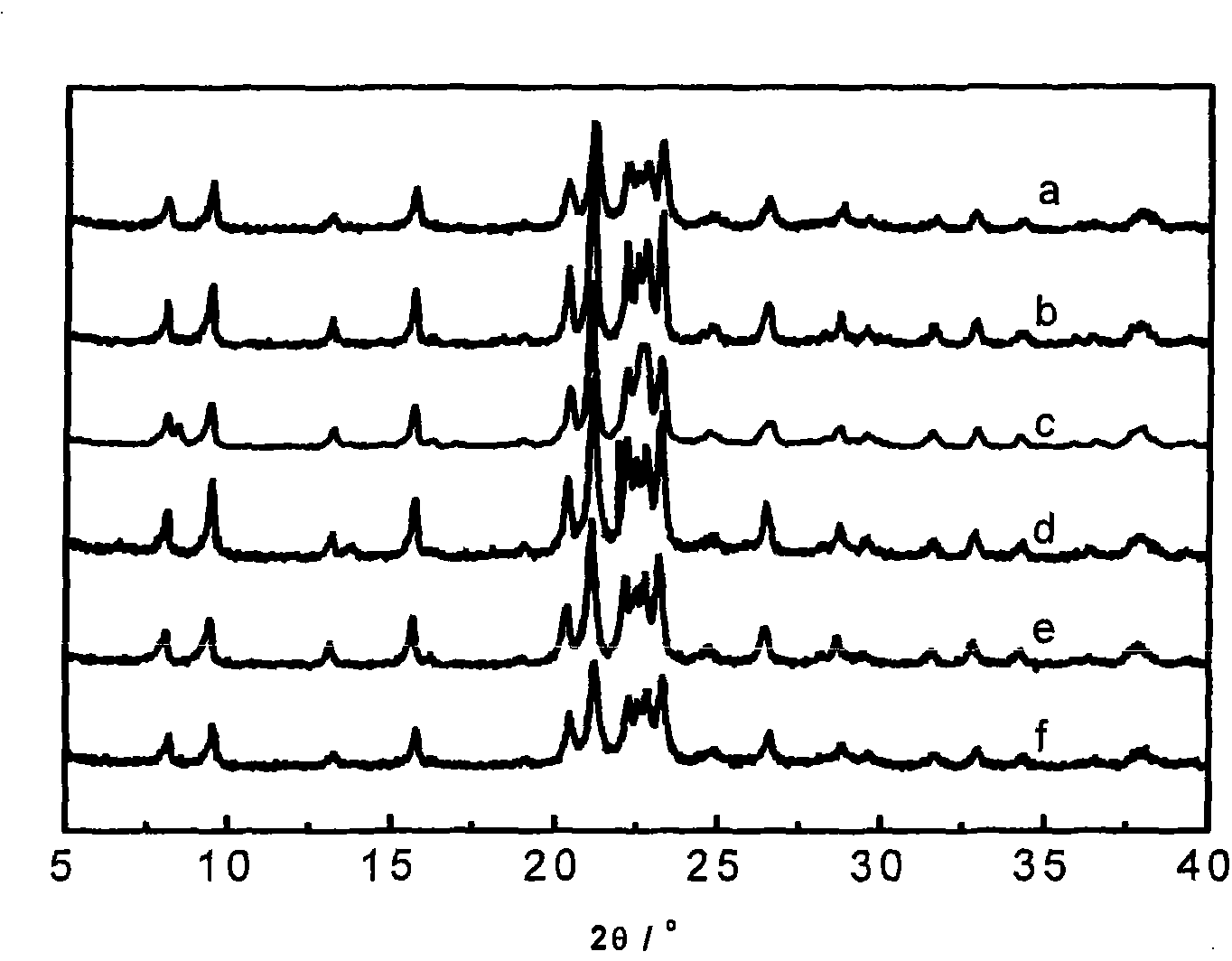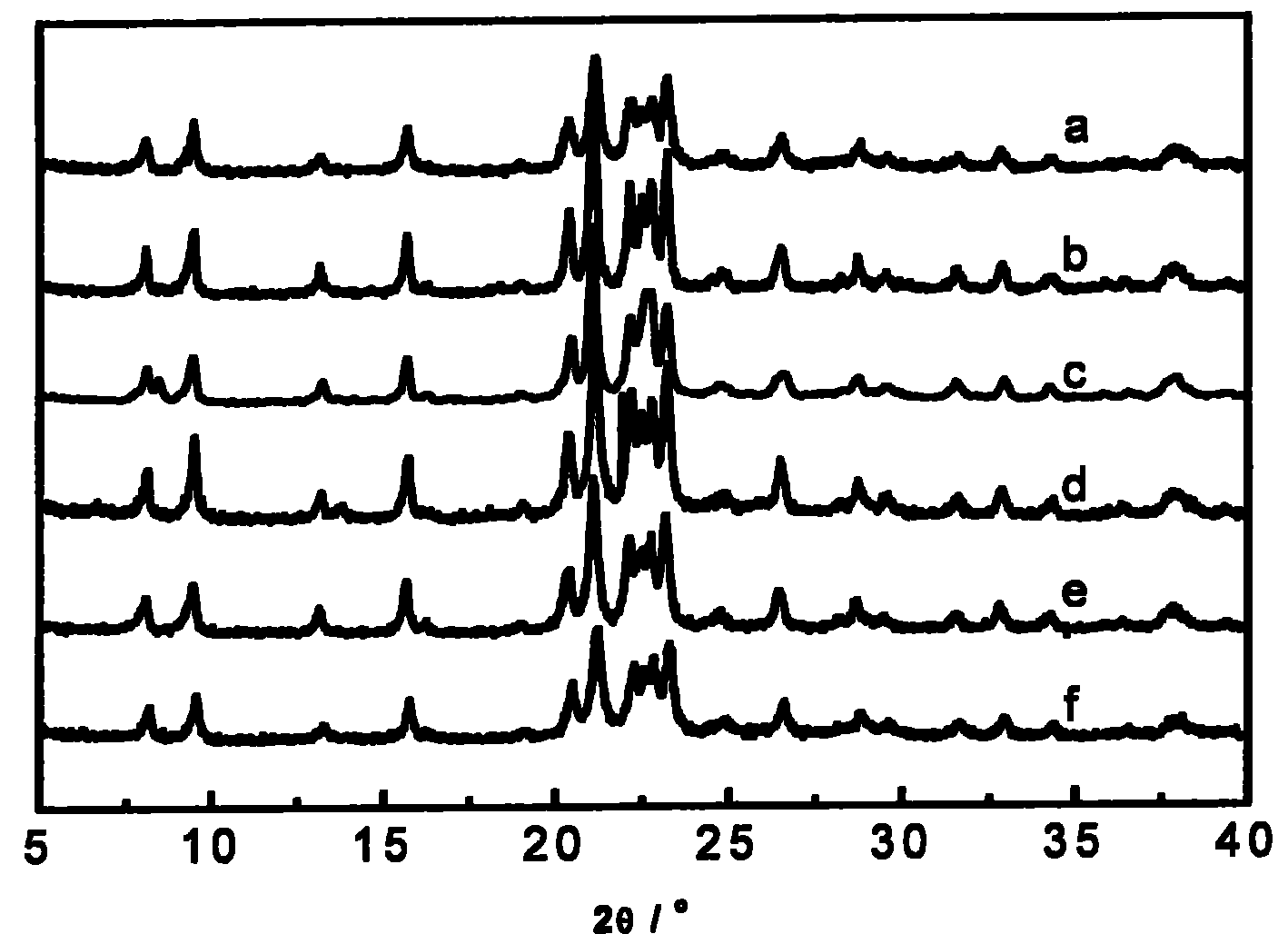Preparations of SAPO-11 molecular sieve and SAPO-11 molecular sieve based catalyst
A SAPO-11, 1. SAPO-11 technology, which is applied in the field of preparation of silicoaluminophosphate molecular sieves and related catalysts, and can solve problems such as being difficult to repeat, not explaining, and limiting isomerization of single-branched chain isomers.
- Summary
- Abstract
- Description
- Claims
- Application Information
AI Technical Summary
Problems solved by technology
Method used
Image
Examples
Embodiment 1
[0031] Example 1. Synthesis of SAPO-11 molecular sieve
[0032] Mix 41.5g of deionized water and 14g of phosphoric acid (AR, 85%, Beijing Chemical Plant) in a 35°C water bath, and then add 9g of pseudo-boehmite (water content 27%, Changling Refining and Chemical Plant Catalyst Plant), Stir for 90 minutes, add a mixed solution of 5.2g propyl orthosilicate (AR, 97%, Shanghai Jingchun Reagent Co., Ltd.) and 11.7g n-propanol (AR, 99%, Shanghai Jingchun Reagent Co., Ltd.), and continue stirring For 120 minutes, slowly add 7.9 g of the template di-n-propylamine (AR, 99%, Beijing Chemical Reagent Company), and continue stirring until a uniform colloid is formed to obtain an initial gel mixture.
[0033] The initial gel mixture was put into a stainless steel reaction kettle lined with polytetrafluoroethylene and crystallized at 185°C for 24 hours. The solid product obtained was taken out, cooled, filtered, and washed with deionized water to a neutral temperature. Dry it at ℃ and calcine a...
Embodiment 2
[0036] Example 2. Synthesis of SAPO-11 molecular sieve
[0037] Mix 65.2g of deionized water and 22.7g of phosphoric acid in a 35℃ water bath, then add 15g of pseudo-boehmite, stir for 90 minutes, add 10.3g of butyl orthosilicate (AR, 97%, Sinopharm Chemical Reagent Co., Ltd. ) And 23.2g of n-butanol (AR, 99%, Sinopharm Chemical Reagent Co., Ltd.) mixed solution, continue to stir for 120 minutes, then slowly add 12.7g template di-n-propylamine, continue to stir until a uniform colloid is formed, and the initial Gel mixture.
[0038] The initial gel mixture was put into a stainless steel reactor with a polytetrafluoroethylene lining, and was airtightly heated to 185°C for constant temperature crystallization for 24 hours, then taken out, cooled, filtered, washed with deionized water to neutral, and dried at 120°C. Dry, calcined at 600°C for 5 hours to obtain SAPO-11 molecular sieve, the X-ray diffraction pattern is as figure 1 As shown in c, the pore structure parameters are shown...
Embodiment 3
[0044] Example 3. SAPO-11 molecular sieve synthesis
[0045] The operation of the synthesis process is the same as in Example 1, but 7.9g of di-n-propylamine is changed to a mixed solution of 7.1g of di-n-propylamine and 1.0g of di-n-butylamine (AR, 99%, Beijing Chemical Reagent Company), and the remaining components and The operation is unchanged, and SAPO-11 molecular sieve is obtained. Its X-ray diffraction pattern is as figure 1 As shown in d, the pore structure parameters are shown in Table 2.
PUM
 Login to View More
Login to View More Abstract
Description
Claims
Application Information
 Login to View More
Login to View More - R&D
- Intellectual Property
- Life Sciences
- Materials
- Tech Scout
- Unparalleled Data Quality
- Higher Quality Content
- 60% Fewer Hallucinations
Browse by: Latest US Patents, China's latest patents, Technical Efficacy Thesaurus, Application Domain, Technology Topic, Popular Technical Reports.
© 2025 PatSnap. All rights reserved.Legal|Privacy policy|Modern Slavery Act Transparency Statement|Sitemap|About US| Contact US: help@patsnap.com



